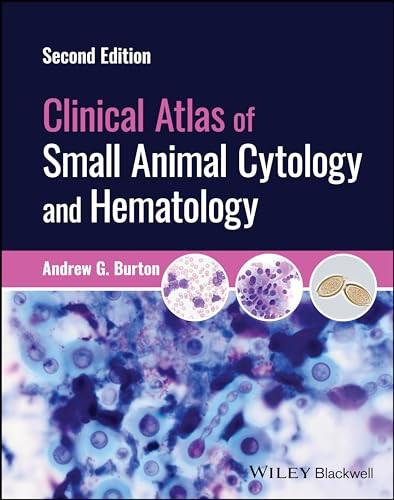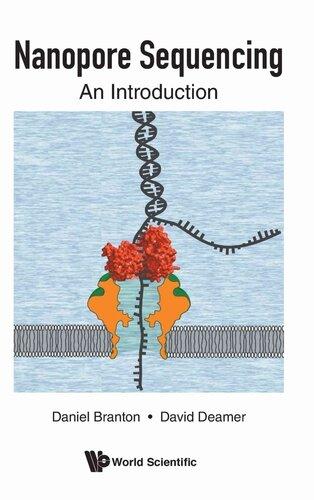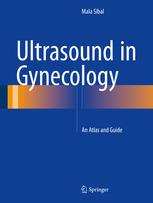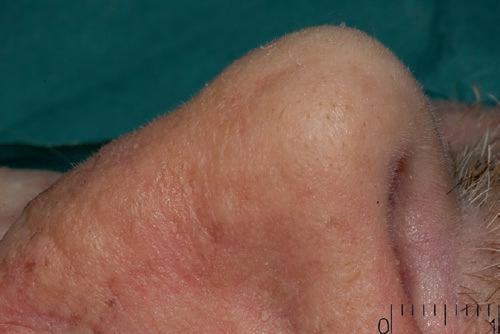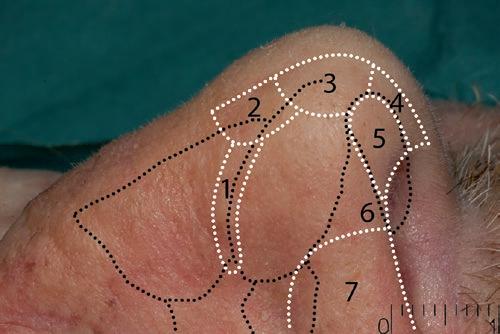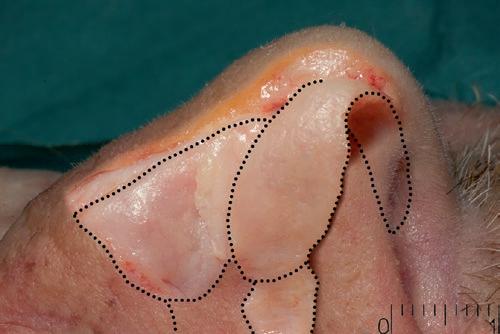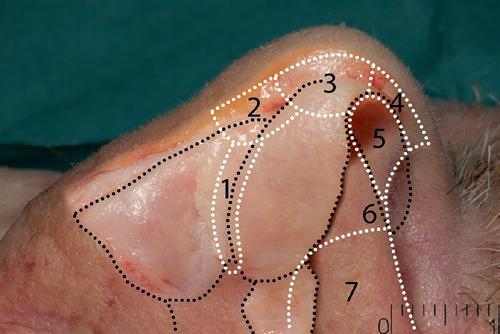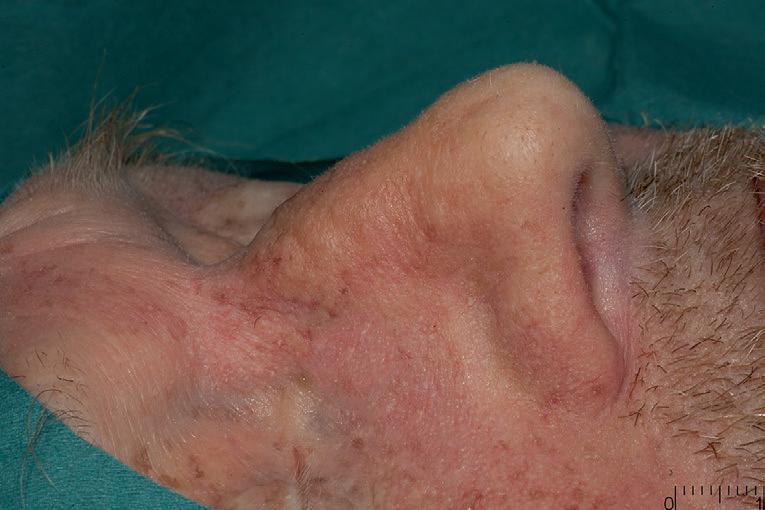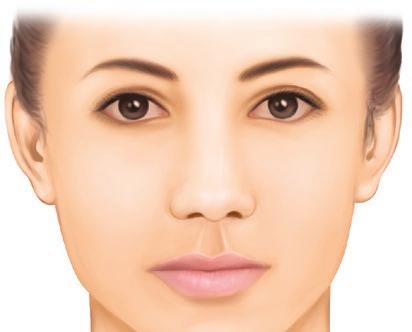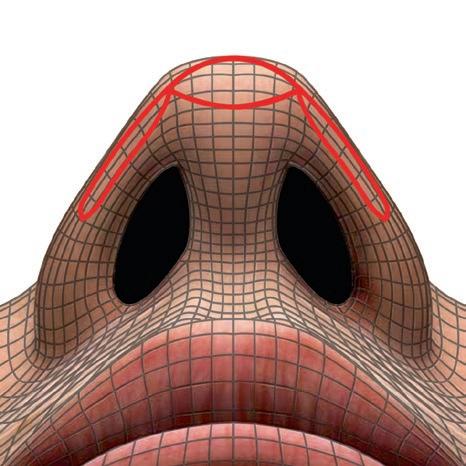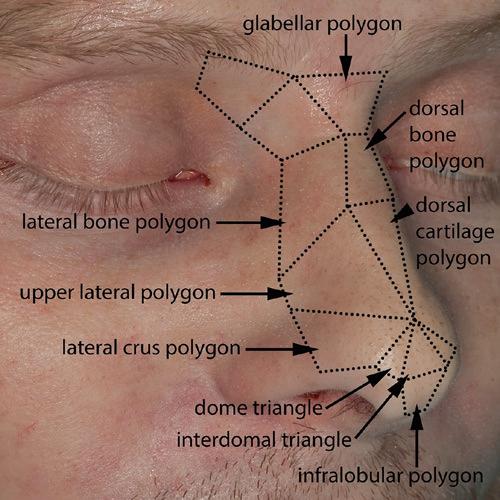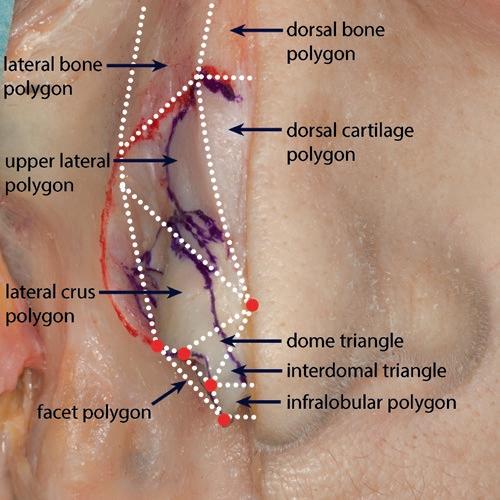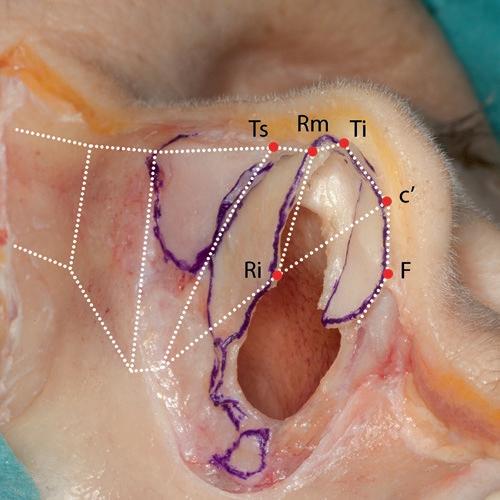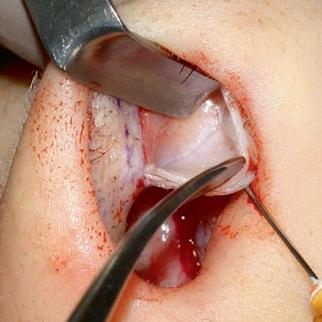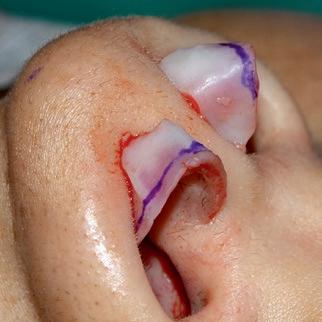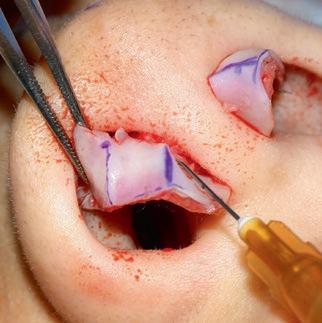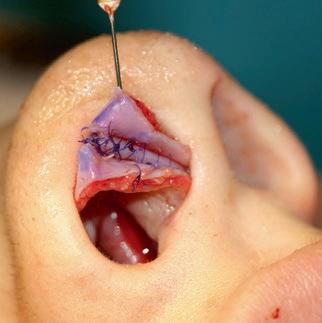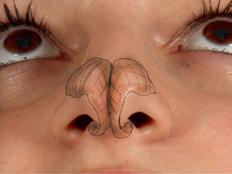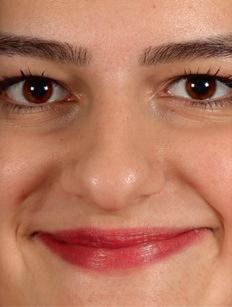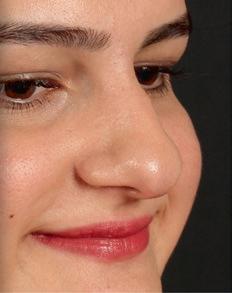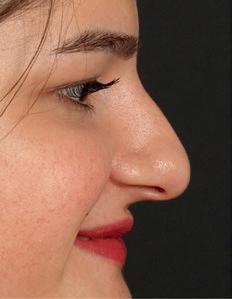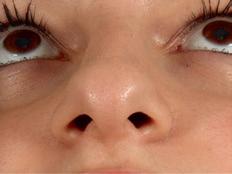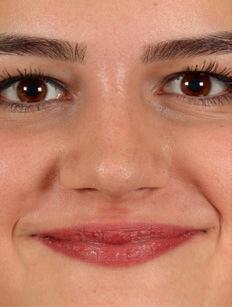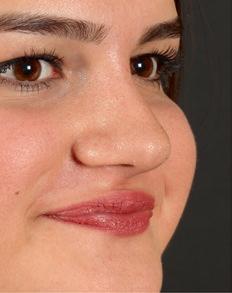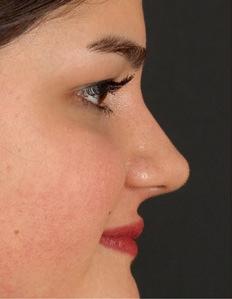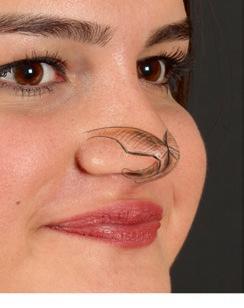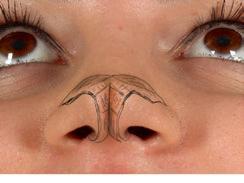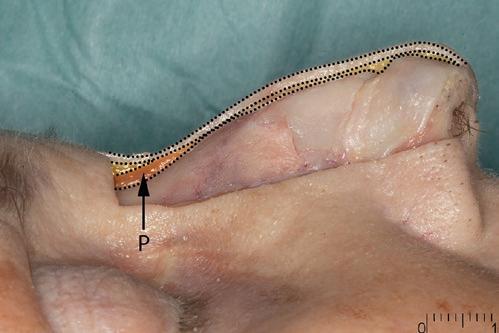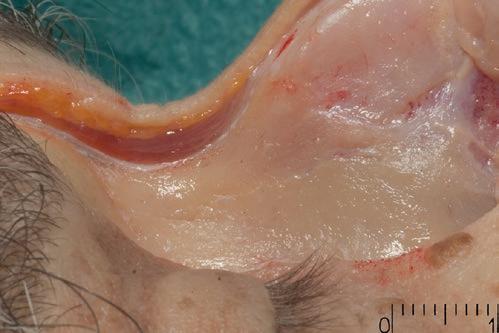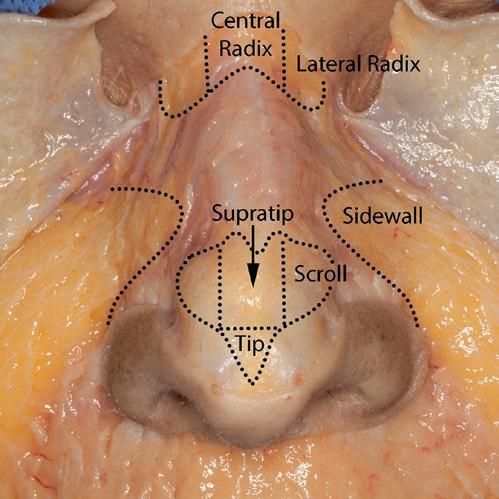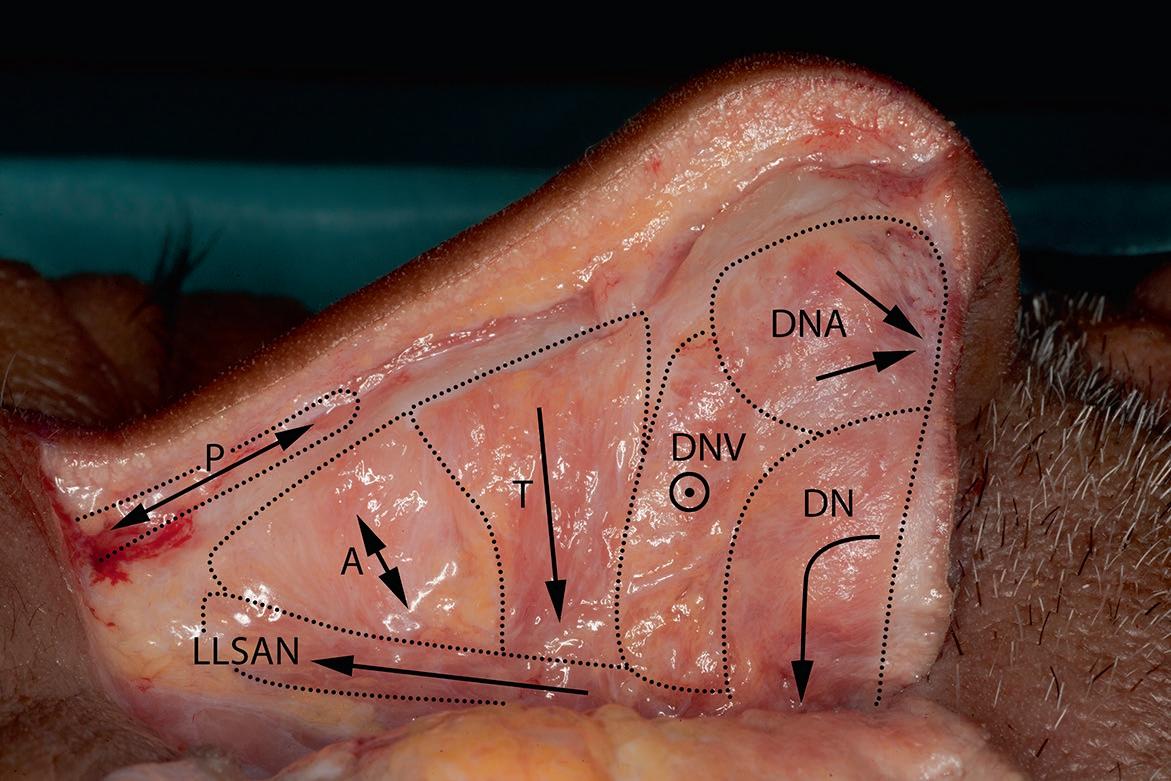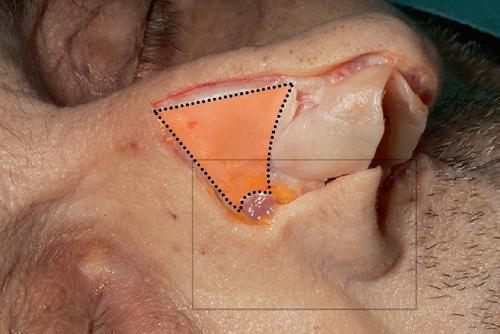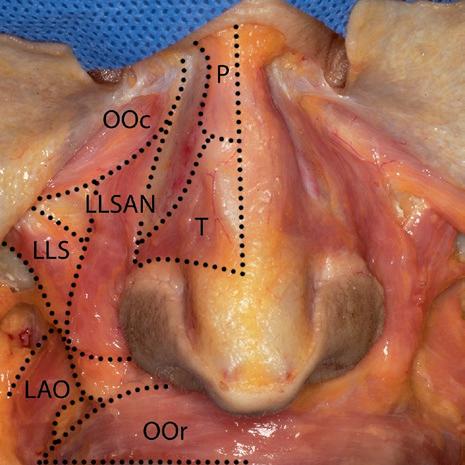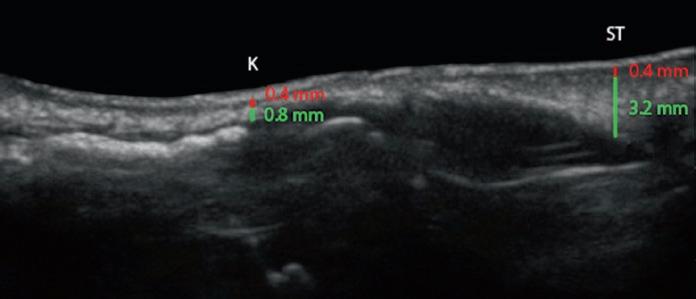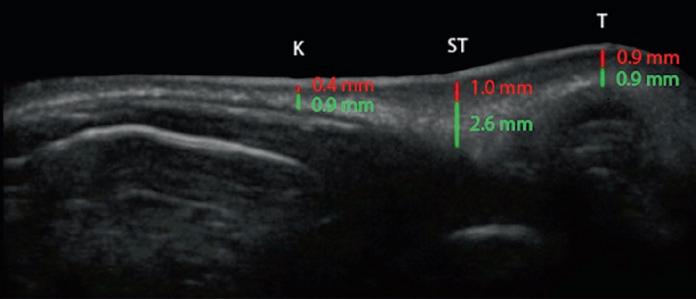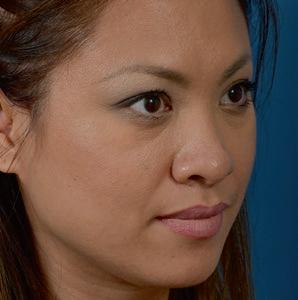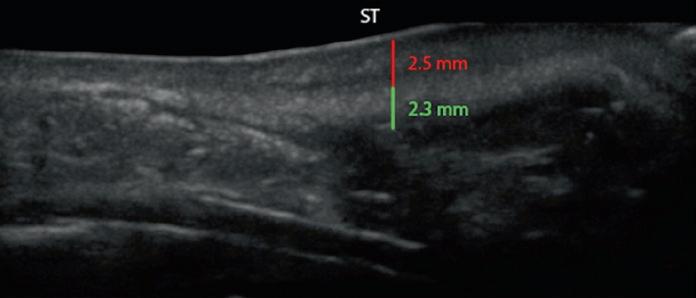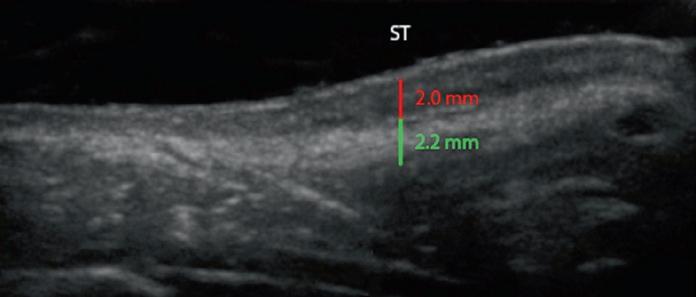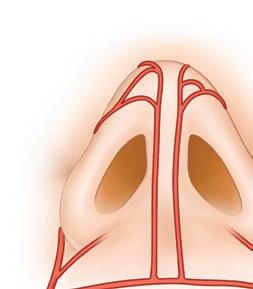Surface Aesthetics and Soft Tissue Envelope 1

Why is the soft tissue envelope (STE) so important in the planning and execution of a rhinoplasty operation? Put simply, the nasal skin envelope covers the underlying osseocartilaginous structures, preventing the surgeon from seeing the true nasal deformity preoperatively and often limiting or compromising the postoperative result. Most surgeons consider skin redraping and remodeling to be the greatest uncertainty in the healing process. The essential purpose of this chapter is to teach the reader how to “see through” the skin and understand the underlying tip and dorsal anatomy. Intraoperatively, three different dissection planes are demonstrated for treating patients with thin, normal, or thick skin. In most cases, a dissection in the avascular deep areolar plane below the superficial musculoaponeurotic system (SMAS) is preferred. In a thick-skin STE, the initial dissection is done in the superficial areolar sub-dermal plane followed by a sub-SMAS dissection with removal of the intervening soft tissue. In thin-skin cases, the dissection plane is in the subperichondrial and subperiosteal plane. Postoperatively, sequential sonograms allow the surgeon to evaluate the healing process and guide the decision to utilize triamcinolone acetonide (Kenalog®) for excessive scar tissue or isotretinoin(Accutane®) for dermal thickening. Ultimately, we are now able to make major changes in nasal shape without being limited by a noncompliant skin sleeve.




Figure 1.1 illustrates the surface landmarks of the nose: (1) glabella, (2) nasion, (3) rhinion (keystone point), (4) supratip, (5) tip, (6) infratip lobule, (7) columella, (8) medial canthal ligament, (9) supraalar groove, (10) alar groove, (11) nostril, (12) alar crease, (13) nasolabial fold, (14) columellar pillar, (15) columellar base, (16) philtrum, (17) soft tissue
Fig. 1.1 (a – d) Surface landmarks
facet (triangle), (18) nostril sill, (19) philtral crease, (20) alar sidewall.
Fig. 1.2 (a – f ) Topographic landmarks. Note: all photographs are taken with a fixed position camera allowing exact overlays.
Figure 1.2 demonstrates topographic landmarks and areas: (1) scroll area, (2) supratip, (3) tip, (4) infralobular triangle, (5) soft tissue facet, (6) nostril rim, (7) alar lobule, (8) nostril sill, (9) columellar base, (10) columellar pillar.
Fig. 1.3 The soft tissue envelope of the nose: (a) Skin. (b) Subcutaneous fat and superficial musculoaponeurotic system (SMAS). (c) Osseocartilaginous skeleton underlying the soft tissue envelope. Note: all photographs are taken with a fixed position camera which records accurate sequential dissection.
Surgeons must develop the ability to “see through” the mask of the skin envelope and visualize the underlying osseocartilaginous foundation of the nose. Figure 1.3 was created with a “fixed position” camera, which allowed an exact sequential delayering of the nose. The STE is composed of the epidermis, dermis, subcutaneous fat, and the superficial musculoaponeurotic system (SMAS), which varies dramatically in component thickness from cephalic to caudal in the same individual, and even more dramatically between patients. The skin itself can be divided into a thin upper half and a thicker lower, sebaceous half. In many ethnic noses, the surgeon is challenged to visually integrate the two parts of the skin envelope, often with solid dorsal cartilage grafts. The subcutaneous fat is localized in the supratip area, the radix, and the lateral nasal wall. If one thinks of layers as opposed to planes, there are five layers: (1) skin, (2) superficial areolar layer, (3) SMAS, (4) deep areolar layer, and (5) perichondrium-periosteum.





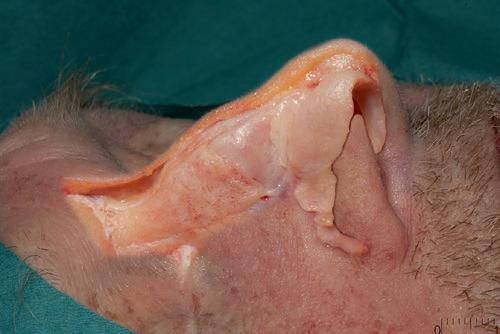
The two areolar layers become relatively avascular dissection planes. The nasal SMAS integrates and transmits the contraction forces of the nasal musculature (Fig. 1.4). Preservation of the SMAS is desirable from a functional perspective and in maintaining adequate long-term padding of the skin. Recently, surgeons have begun to dissect in a subperichondrial-subperiosteal plane that maintains the integrity of the STE and reduces damage to the neurovascular structures (Çakir et al. 2012).
Fig. 1.4 (a, b) Subcutaneous fat pads. (c , d) Muscles. (e, f ) Osseocartilaginous skeleton of the nose
Until publication of Aesthetic Rhinoplasty in 1978 by Jack Sheen (Sheen 1978), surgeons analyzed the nose in almost an architectural manner using angles, lines, planes, and profilometers (Fig. 1.5). Sheen’s emphasis on aesthetics revolutionized preoperative analysis and postoperative evaluation, especially as regards tip surgery. On front view, he emphasized the divergent concave dorsal lines that connect the superciliary ridge of the orbit through the radix to the tip. He visualized the tip as two equilateral geodesic triangles with a common base, the length being the intercrural distance. The apex of the superior triangle is the point of tip differentiation, and the apex of the inferior triangle is the point of columellar lobular junction. Interestingly, the apogee of the intercrural line should be the highest point of the tip.
Fig. 1.5 (a – d) Surface aesthetics according to Sheen (1978)
Toriumi (2006) introduced the concept of nasal tip contour as a series of surface highlights and shadows created by underlying anatomical high points and low points (Fig. 1.6). Specifically, the tip is represented by a horizontal tip highlight corresponding to the domes, with continuation of the highlight as an elevated ridge in continuity with the alar lobule. Surgically, this tip highlight can be created with a domal onlay graft, while the elevated ridge along the alar margin will be accentuated by an alar rim graft. Equally important, a shadow in the supratip region continues laterally into the alar groove, thus setting off the tip. Excision of cephalic crura emphasizes the supratip breakpoint and moves it caudally, setting off the tip. The linkage between surface aesthetics and surgical techniques is readily apparent in Toriumi’s operative procedures.
Fig. 1.6 (a – d) Surface aesthetics according to Toriumi (2006)
Fig. 1.7 Cakir's concept of the aesthetic nasalpolygons. (a, b) Surface polygons. (c , d) Points defining the polygons of the nasal tip
Çakir et al. (2012) and Çakir (2016) introduced the concept of polygons for analyzing the aesthetics of the nose, based on artistic principles from drawing and sculpture. Essentially, the nasal polygons are geometric forms derived from a composite of lines, shadows, and highlights, with specific proportions and breakpoints (Fig. 1.7). The osseocartilaginous vault is comprised of two bony polygons (dorsal and lateral) and two cartilaginous polygons (dorsal and lateral). Importantly, Çakir notes that the dorsal aesthetic lines are not straight, but rather “fusiform”—narrow in the radix, wider at the keystone, and narrow again at the supratip. On basilar view, one sees the infralobular, columellar, and footplate polygons.
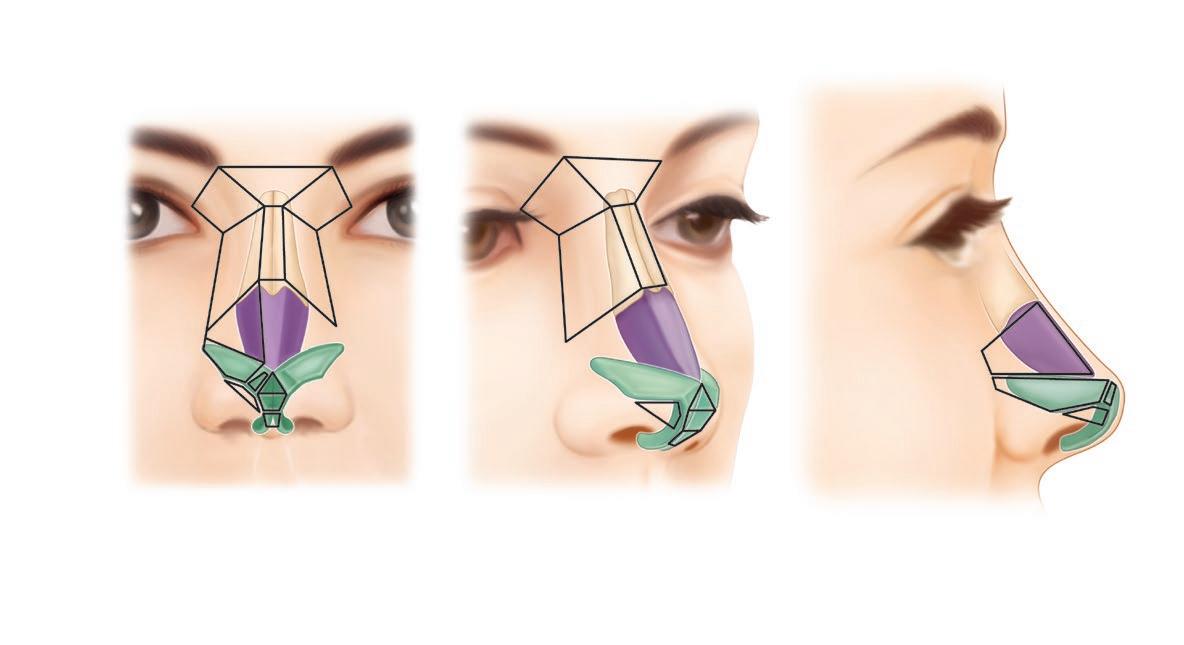


Çakir conceives of the nasal tip as being comprised of two mass polygons (dome triangles, lateral crus polygons) and two space polygons (interdomal triangle, facet polygons). The domal triangle is defined by three points (Ts, Ti, Rm); the interdomal triangle is defined by Ts superiorly and Ti on either side. Aesthetically, Ts is the superior tip point, Ti the inferior tip point, and Rm the medial rim point. Anatomically, Ti corresponds to the medial genu of the domal notch, and Rm to the lateral genu of the domal notch. The facet polygon is bordered by Ti to Rm at the top and C to Ri at the bottom (Fig. 1.7b). Anatomically, C corresponds to the columellar breakpoint (c′) and Ri to the turning point of the lateral crus. The lateral crus polygon is a mass polygon comprised of the body of the lateral crus. There are distinct variations in males and females (Fig. 1.8).
Fig. 1.8 Cakir's concept of the aesthetic nasalpolygons. (a – c) Polygons. (d, e) Variations in men and women
polygons: case study (courtesy of dr. bariş Çakir)
This case study shows that one can modify and surgically achieve the desired aesthetic polygons.
Analysis: A 23-year-old woman presented for rhinoplasty. She had a boxy tip, with the lateral crus too wide, long, and convex, plus a too obtuse resting angle. These deformities created the look of cephalic malposition. Patients with this deformity are at great risk for pinch nose, alar retractions, and nostril asymmetries because they generally need cephalic lateral crura resection more than 5 mm. Bulbous tips generally have excess at the caudal border of the lateral crura.
Operative Technique: This surgery used a closed technique with a 3-mm auto-rim flap. Pitanguy’s dermocartilaginous ligament was preserved (Fig. 1.9). Figure 1.10 illustrates the changes.
1. Trans-septal transfixion incision with 1 mm of caudal septum left on the columellar side.
2. The nasal dorsum exposed in a subperichondrial and subperiosteal plane.
3. 2 mm caudal and 3 mm cephalic excision of the lateral crus.
4. 5 mm lateral crural steal on both sides.
5. 3 mm medial crural overlap, followed by insertion of a partial-length columellar strut.
6. The lateral crus resting angle was corrected using a cephalic dome suture.
7. The footplates were sutured to each other with 5/0 Prolene®.
8. Lateral ostectomy was used for closing the open roof. Libra grafts were placed.
9. The trans-septal transfixion incision was closed by suturing the two portions of the caudal septum together.
10. Vertical scroll ligament was repaired with 5/0 PDS® II and mucosa was closed with 6/0 Monocryl® sutures.
Commentary: An important aesthetic concept is the resting angle between the lateral crus and the upper lateral cartilage which should be 100°. Importantly, the caudal border of the lateral crus rises above the cephalic border and the facet polygon is opened. Treatment of the lateral crura caudal excess with auto-rim flap decrease alar rim retractions and nostril asymmetries.
Surface Aesthetics and Soft Tissue Envelope
polygons: case study (courtesy of dr. bariş Çakir)
Fig. 1.10 (a – p) Case study patient before rhinoplasty (left) and 1 year after surgery (right)
skin thickness and layers



The thickness and composition of the soft tissue envelope (STE) varies dramatically in different areas of the nose. In the midline, the STE is the thickest in the upper third, thinnest in the middle third, and highly variable in the lower third (Fig. 1.11). The thickness of the soft tissue is determined by the thickness of the dermis, subcutaneous fat, and SMAS (Figs. 1.12 and 1.13). The dermal thickness is very thin over the rhinion and very thick in the supratip area. There is a distinct difference in the skin type in the lower 40% of the STE (sebaceous, oily, prone to rosacea) and the thinner upper 60%. For this reason, one often uses solid dorsal grafts beneath diced cartilage grafts wrapped in temporal fascia (DC-F grafts) to augment the dorsum in black patients. One is attempting to “unify” the two skin sleeves—the transverse, thick, heavy lower lobular skin sleeve and the longitudinal, thin, upper dorsal skin sleeve. In thin-skin noses, all layers are thinner, and sometimes the smaller muscles are not even recognizable. In these cases, fascia is often added to cover the tip structures and prevent them from “showing” through the skin. In thinskin patients, the middle third of the nose must be meticulously repaired using spreader grafts or flaps to avoid
Fig. 1.11 Skin thickness in the midline
Fig. 1.12 Variations in dermal thickness in the middle third (same scale): (a) thin and (b) thick
skin thickness and layers
an inverted-V deformity. More commonly, the challenge is how to deal with a thick STE, and especially how to achieve tip definition when the skin is unable to shrink onto the rigid underlying structure. In general, thick skin precludes subtle corrections and requires overcorrection. The cartilaginous tip angles must be sharper, and often tip grafts are set higher above the domes to show through the skin. Thick skin can be treated with defatting of the subcutaneous fat layer, but defatting must be done cautiously to avoid skin necrosis. The thickness of muscles also affects the total thickness of the skin, especially in the glabellar region, where the procerus muscle can be found (Fig. 1.13).
Fig. 1.13 Layers of the STE comprise the dermis (white), subcutaneous fat ( yellow), and muscles (orange). (a, b) Thick skin, (c , d) thin skin, (e, f ) muscular and fatty glabellar skin: note reciprocal relationship. DN dilator naris muscle; P procerus muscle; T transversalis muscle


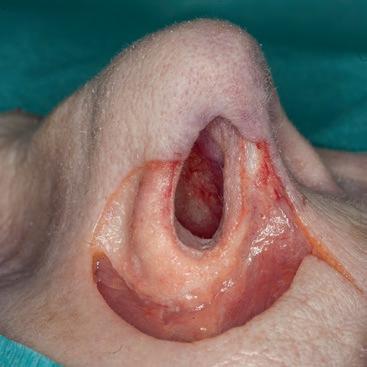


The concept of the tela subcutanea cutis originates from anatomical descriptions (Goss 1973). Traditionally, surgeons concentrated on bony and cartilaginous components while ignoring the existence of a distinct fibrous structure underneath the skin, which gives form to the lower nasal base (Fig. 1.14). When we meticulously dissect the skin off the lower nasal base, it becomes obvious that the structure of the nostril sill and alar lobules is maintained (Daniel et al. 2013). Histologically, the curl of the nostril sill and the shape of the alar lobule are due to fibrous septae running from the deep dermal surface into the underlying muscles (Fig. 1.14c–e). This area is a distinct soft-tissue entity independent of the adjacent cartilages and underlying bones. Reduction of the nostril sills requires direct excision. The exception is the under-projecting tip with round nostrils, which can be mobilized medially onto a rigid columellar strut.
tela subcutanea cutis
Fig. 1.14 (a) The extent of the tela subcutanea cutis (TSC), (b, c) The TSC determines the shape of the alar lobule and nostril sill, (d, e) Extent of TSC shown in cross-section and lateral extent. LLC lower lateral cartilage
subcutaneous fat pads and interdomal fat pad
c d
1.15 Subcutaneous fat pads. (a, b) Cephalic and central subcutaneous fat pads. (c , d) Interdomal fat pad anatomically and clinically
The subcutaneous fat of the nasal region can be divided into three portions: cephalic, central, and lateral (Fig. 1.15). The cephalic subcutaneous fat can be subdivided into a central and lateral radix fat pad. The central radix fat pad overlies the procerus muscle while the lateral radix fat pad lies on the bone between the procerus and depressor supercilii muscle. The central subcutaneous fat can be subdivided into the tip, supratip, and scroll area fat pad. The tip subcutaneous fat pad lies above the interdomal fat pad. Interestingly, the tip subcutaneous fat pad does thin out around the domes, which means that the tip-defining points are basically cartilage-related. The interdomal fat pad is obvious at the time of surgery in most patients and has been confirmed on sonogram studies. Importantly, the presence of an interdomal fat pad answers one of the great mysteries of nasal aesthetics: What is the anatomical determinant of “T”? Ever since Sheen said that the tip (T) is the highest point on lateral view, it was implied that it is higher than the domes of the alar cartilages, yet what is it? In most patients, the tip convexity is created by the interdomal fat pad. In thin patients, one can see the convex domes through the skin, but the tip is often flat, not curved, because of a minimal interdomal fat pad.
Fig.
superficial musculoaponeurotic system (smas)
1.16 (a) Muscles of the SMAS: procerus (P), anomalus (A), transverse nasalis (T), dilator naris vestibularis (DNV), dilator naris anterior (DNA), dilator naris (DN), levator labii superioris alaeque nasi (LLSAN). (b, c) Relationship of the transverse nasalis muscle (T) to the alar crease and the nasolabial fold at the level of the mucosal space
As originally described by Letourneau and Daniel (1988), the nose is covered by a nasal superficial musculoaponeurotic system (SMAS), which is part of the facial SMAS (Fig. 1.16). An aponeurosis interconnects the superficial muscles of the nose, thus distributing their forces. The muscles inserting into the alae come off from the maxilla and can affect nasal respiration by changing the transnasal pressure of the nasal valves (Saban et al. 2008). There are numerous descriptions of the nasal musculature, but we prefer our own cadaver macroscopic observations. Griesman (1944) divided the muscles functionally into four groups: elevators, depressors, compressors, and minor dilator muscles (Figs. 1.17 and 1.18).
Elevators, including the procerus (P) and levator labii superioris alaeque nasi (LLSAN), shorten the nose and dilate the nostrils. P originates from the aponeurosis of the transverse nasalis and the periosteum of the nasal bones, before inserting into the glabellar skin. LLSAN originates from the periosteum of the frontal process of the maxilla, medial to the orbicularis oris muscle, and inserts some fibers into the ala, but it mainly inserts into the modiolus nasi and the columellar base.
Fig.
superficial musculoaponeurotic system (smas)

Depressors lengthen the nose and dilate the nostrils. They include the depressor septi nasalis (DSN), dilator naris or alar portion of the nasalis (DN), myrtiformis muscle (M), and the superficial orbicularis oris nasalis (SOON). The DSN originates from the periosteum of the maxilla above the central incisor, and inserts onto the footplates of the medial crura and the deep layer of Pitanguy’s midline ligament. The main portion of the DN originates from the periosteum of the maxilla above the canine tooth, just lateral to the origin of the myrtiformis muscle and medial to the origin of the transversalis muscle. A less obvious caudal portion of the DN originates from the superficial layer of the modiolus nasi. DN inserts into the alar base and thus becomes the main dilator of the nostril. M originates from the myrtiform fossa of the maxilla, just above the lateral incisor and canine teeth. It divides into an anterior labial part, which goes to the upper lip, and a posterior nostril part, which inserts on the nostril floor. It depresses and dilates the nostrils.
Compressors lengthen the nose and narrow the nostrils. They include the transverse nasalis (T). T originates from the periosteum of the maxilla above and lateral to the incisor fossa. It interdigitates on the nasal dorsum with its counterpart from the opposite side and the procerus muscle to form a sling. The belly of the muscle overlies Hocksteder’s mucosal space, thus allowing it to function as a bellow. Some fibers insert into the skin of the nasolabial fold and alar crease, as well as join the dilator naris muscle. Contraction of this muscle results in downward movement of the cephalic rim of the lateral crura, thus compressing the vestibule.
Fig. 1.17 Nasal musculature. Orbicularis oris (OO), transversalis (T), depressor septi nasalis (DSN), myrtiformis (M), dilator naris (DN), levator labii superioris alaeque nasi (LLSAN), lower lateral cartilage (LLC ), procerus (P), and mucosal space (MS)
superficial musculoaponeurotic system (smas)
Fig. 1.18 (a – d) Nasal SMAS. Procerus (P), orbicularis oculi (OOc), levator labii superioris alaeque nasi (LLSAN), transverse nasalis (T), levator labii superioris (LLS), levator anguli oris (LAO), orbicularis oris (OOr), dilator naris anterior (DNA), dilator naris (DN), depressor septi nasalis (DSN0, myrtiformis (M)
As emphasized by Figallo and Acosta (2001), the nasal muscles have been “sliced and diced” over the years into numerous entities, with certain ones dropped for decades, only to be resurrected. Currently, the concept of the SMAS layer covering the entire nose has become accepted. This continuity of muscle coverage and its actions through an aponeurosis with ligamentous attachments has altered our concepts of nasal respiration. One of the most recent discussions has revolved around the “dilator naris” and the “modiolus” of the nose Traditionally, there was a question as to whether the dilator naris was a part of the transverse nasalis muscle (T) or a separate entity. Currently, we tend to think there are three dilators: the dilator naris (DN), the dilator naris anterior (DNA), and the dilator naris vestibularis (DNV). The DNA originates from the surface of the lateral crus and inserts into the nostril rim. It is seen during skin elevation from the infracartilaginous incision. The DNV, which is rarely visible macroscopically, originates from the tail of the lateral crura and the accessory cartilages before inserting into the deep dermal surface of the alar groove (Hur et al. 2011).


superficial musculoaponeurotic system (smas)


As referred to in the oral area, a modiolus is a chiasma of facial muscles held together by fibrous tissue. At the alar base, the modiolus alae nasi is composed of multiple muscles that depress and expand the nostril, thus serving as a counterbalance to the lifting, narrowing muscles. Our dissections defined the existence of a modiolus alae nasi as a two-layer structure (Fig. 1.19). The superficial layer courses transversely and comprises the LLSAN, levator labii superioris, and superficial orbicularis oris, plus the caudal portion of the DN, which has an origin in the modiolus nasi. Based on the course of the individual muscles, it is obvious that their contracture expands the nostril laterally, whereas the predominant levator muscles elevate the nostril base. Functionally, these muscles provide countertension to the depressor muscles. The deep layer courses vertically and comprises the myrtiformis muscle and DN. These fibers have a broad insertion around the entire alar base and up into the nostril sill (Daniel et al. 2013).
Fig. 1.19 Modiolus nasi. (a) Superficial layer. (b) Deep layer. (c) Caudal portion of the dilator naris. (d) Lateral close-up view of LLSAN muscle lateral to the alar lobule. MM myrtiformis muscle
sonogram
Sonogram analysis of the nasal skin is an extremely valuable tool, both for preop and postop analysis in rhinoplasty surgery. Patients found to have thin skin had a dermal thickness at the keystone junction (K) of 0.2 mm (0.1–0.4 mm), compared with 0.36 mm (0.28–0.40 mm) for normal skin and 0.48 mm (0.42–0.63 mm) for thick skin (Fig. 1.20) (Kosins and Obaghi 2017). This difference in thickness also existed in the supratip and tip areas, but these areas were also affected by the oiliness of the skin. Overall, patients with skin that was determined to be oily had a dermal thickness that was 25% thicker at the supratip and 34% thicker at the tip area. Soft tissue thickness underlying the dermis was variable. Patients of non-Caucasian background were more likely to have a thicker soft tissue layer. Patients with thick skin can be divided into those with thick dermis, thick underlying soft tissue, or both.
Fig. 1.20 Sonograms of nasal skin, showing the thickness of the dermis (red ) and SMAS ( green). (a, b) Thin skin. (c , d) Medium skin. (e, f ) Thick skin. K keystone junction; ST supratip; T tip (Sonograms courtesy of Aaron Kosins, MD.)
Fig. 1.21 Patient with a thick-skin STE composed of a thick lower part and thin upper part. (a, b) Preop sonogram and photo. (c , d) Views 4 weeks postop, prior to start of Accutane®. (e, f ) Views 4 months after surgery and 3 month course of Accutane. The vertical measurements show dermis (red ) and SMAS ( green). Note: there has been a full 1 mm thinning of the dermis (33%) and 0.6 mm of the deep soft tissue (25%). ST supratip; T tip
Patients who have a thick dermis benefit from preconditioning with a combination of salicylic acid, mechanical scrub, alpha hydroxyl acids, and retinoids to shrink the oil glands. Patients who have thick underlying soft tissue are routinely defatted using an open approach by dissecting at a subdermal level, followed by resection of the intervening soft tissues down to the cartilage level. Selected patients benefit from a postoperative treatment program with either 20 mg of isotretinoin (Accutane®) started at 4 weeks and continued for 4–5 months to decrease the size of the oil glands, with optional CO2 Fraxel® (Solta Medical; Hayward, CA) for textural smoothing. The patient shown in Fig. 1.21 had extremely thick skin, which was defatted intraoperatively. A dorsal graft was inserted to unify the two skin sleeves. sonogram
neurovascular structures
Alar arcade
Columellar artery Facial artery
The arterial blood supply to the nose comes via three distinct vessels: the lateral nasal artery, columellar artery, and dorsal nasal artery (Fig. 1.22). The facial artery divides into a superior labial artery and an angular artery near the labial commissure. A pair of columellar arteries branch off of the superior labial artery in the middle of the upper lip. The lateral nasal artery branches off of the angular artery at the level of the alar groove and runs along the cephalic margin of the lateral crus. The dorsal nasal artery is a continuation of the ophthalmic artery. All of these vessels are interconnected through vascular arcades and terminate in the dermal plexi. As emphasized by Toriumi et al. (1996), the vascular system was found in the subcutaneous plane above the SMAS layer. Surgically, dissecting in the areolar plane below the SMAS leads to minimal disruption of the vasculature and bleeding.
Dorsal nasal artery Lateral nasal artery
artery
Facial artery Superior labial artery
Columellar artery
Alar arcade
Superior labial artery
Subnasal artery
Subnasal artery
Fig. 1.22 (a – c) Arterial anatomy
Another random document with no related content on Scribd:
interviews for preliminary negotiation or merely to casual scoutings for opportunities of profit, Mr. Dobb’s aim was to appear fresh and impeccably groomed and, as far as possible, aristocratic. Careful study of toilet and deportment, he was convinced, must inevitably bring him the pleasing reputation of being a leader of fashion, and, furthermore, could not but impress people with the desirability of dealing with so distinguished a person when they had rickety sofas and deficient clocks and old ironmongery to sell.
And so Mr. Dobb was sauntering forth in all his accustomed splendour. Upon his sleekly anointed hair there rested a soft felt hat of exceeding plushiness, with a tuft of strange feathers thrust into its band to hint at sporting prowess. A very high and very stiff collar encircled Mr. Dobb’s throat, and upon a necktie of cheerful patterning there was pillowed a scarfpin conspicuously, like the headlight upon a locomotive. A shaggy tweed suit, of a hue which far o’erleapt snuff and only narrowly missed mustard, graced Mr. Dobb’s frame, and his feet were encased in orange-coloured boots of a squeakiness surely without parallel.
And when the eye had become inured to these glories, returning powers of vision brought apprehension of a silver-mounted cane, of a buttonhole of geranium blooms, of a cigar, and a festooning watchchain, and of the phenomena of tan gloves, not worn on the hands, but carried carelessly, as though their presence were due to a merest afterthought on the part of lazy luxury.
And thus, as it were, glossed and burnished and intensified, Mr. Dobb progressed down Fore Street. One hand jauntily twirled the cane, the other hand not only had the distinction of flourishing the gloves in airy greeting of such neighbours as Mr. Dobb insisted should see him, but also was called on, from time to time, to assist in making great play with the cigar, a duty which it performed with many graceful twirls of the wrist.
And thus did Mr. Dobb arrive at the corner where Fore Street joins Bridge Street, and here he paused to gaze up and down the road. A fine sense of dominance permeated Mr. Dobb as he stood there, and
the expression with which he viewed the amenities of the place was one nicely calculated to hover midway between languid interest and patrician disdain.
And then, as an ancient ewer may be rare and valuable ware in one moment and, in the next, be but so much broken crockery, so in a twinkling was Mr. Dobb transformed from a proud autocrat to a quaking fugitive.
Gone was all trace of hauteur from his face, vanished completely was all swaggering complacency of manner. There was a hunted look in his eyes, and he had become limp and drooping and manifestly unstable at the knees.
And the whole change had happened in that trice which is occupied by the clash of two pairs of eyes meeting each other in a glance of recognition across a narrow thoroughfare.
“’Strewth!” breathed Mr. Dobb, aghast, and made a convulsive, clutching movement towards his hat, but checked his arm halfway. “’Strewth!” he said again, but even more emphatically; and then spun round on his heel and began to retrace his way along Fore Street at a pace in marked contrast to his previous gait.
Regardless of the ill-concealed amazement of acquaintances, Mr. Dobb cantered wildly adown the pavement until he reached his abode, and here he breathlessly flung himself through the doorway, locking the portal behind him in a manner which clearly indicated panic. Mrs. Dobb, appearing in surprise from the back parlour, addressed a very natural question to her husband.
“Why—” he began, and then stopped and stared at his wife as though the situation had suddenly unfolded itself to exhibit a further cause for consternation.
And next he frenziedly unlocked the door and plucked the portal open, and plunged out again into the street. Glimpse of a figure in the distance served efficiently as spur, and Mr. Dobb raced wildly away in the opposite direction. Not until he had swerved round three
successive corners did he feel emboldened to moderate his pace, and even then he travelled at something approximating a canter.
But at last he came to the region of the harbour, and reaching the “Flag and Pennant” shipway, he vigorously semaphored for the attendance of the ferryman stationed there. On his hasty arrival, that functionary found himself directed to take Mr. Dobb across the river with the utmost possible speed.
Mr. Samuel Clark, the ferryman, well used to the vagaries of his present patron and former shipmate of the “Jane Gladys,” made no immediate comment, but assisted his passenger into the boat and began to transport him with commendable energy. Mr. Dobb, removing his high collar and thrusting it into his pocket, made the noises of one narrowly saved from suffocation, and gazed fearfully over his shoulder at the receding river bank.
“I—I—I ain’t got the breath to hexplain now, Sam,” he puffed, presently. “Put me down over there by the ‘Red Lion,’ and then go back and make up a yarn. And get some one to take your place. And then go and fetch Peter Lock and Joe Tridge, and bring ’em over yonder to me at once.”
“Doings?” asked Mr. Clark, with the liveliest expectancy.
“Not ’alf!” was Mr. Dobb’s reply. “Not ’alf!” he said again; and shivered perceptibly.
In face of this discouraging reply, Mr. Clark had not the hardihood to press for more explicit information. Ever one to concede that there was a wrong time and a right time to appeal to Mr. Dobb’s confidence, the look on that gentleman’s face warned him that this was indubitably one of the wrong times.
In pondering silence, therefore, did the plump and ancient ferryman bend his best efforts to conveying Mr. Dobb to the further side of the harbour, and when this had been achieved, he immediately put about to accord loyal and unquestioning fulfilment to the remainder of Mr. Dobb’s instructions.
Well within the hour, Mr. Clark returned in convoy of Mr Tridge and Mr. Lock, and the three entered the presence of Mr. Dobb in the otherwise vacant tap-room of the “Red Lion.”
Mr. Dobb had recovered some meed of his composure in the interval, but the rosiness of complexion induced by violent exercise had now faded to an ascetic pallor, and his eyes looked up dully from deep and dark circles. Evidence of his mental state was afforded by the fact that he was sitting on his ornate hat.
“Lummy, ’Orace, you do look upset!” observed Mr. Tridge, in concern.
“He looks real downright bad,” asserted Mr. Lock.
“’E looks ’orrible,” was Mr. Clark’s contribution.
Mr. Dobb, gazing with lack-lustre eyes from one to the other of his old shipmates, shook his head forlornly and gave vent to a sigh of extraordinary duration.
“Why, ’e looks as if ’e’d seen a ghost,” declared Mr. Tridge.
“I ’ave,” said Mr. Dobb; “that’s just what I ’ave seen. A ghost—a real live ghost!”
Mr. Tridge threw a startled glance at the empty tumbler standing before Mr. Dobb.
“No, it ain’t that,” said Mr. Dobb, comprehending. “That is only the third I’ve ’ad all day. It’s a real ghost I’ve seen. A ghost from out of the past,” he ended, with a fugitive gleam of pride in the quality of this phrase.
Mr. Lock, his head a little on one side, speculatively scrutinized this beholder of visions. Mr. Tridge and Mr. Lock stared at each other in a baffled way, and privately intimated a mutual disbelief in the sanity of their friend.
“Boys,” said Mr. Dobb, “she’s ’ere.”
“Which she?” cried Mr. Tridge, not without perturbation.
“’Oo do you think?” dallied Mr Dobb.
“Not—not that widder woman from Teignmouth, that Mrs. Larstick?” queried Mr. Clark, shakily. “Not ’er? That I do ’ope. Don’t say it’s ’er?” he begged.
“N-n-n-nor y-y-y-yet th-th-th-that—” stammered Mr. Tridge, clearly lacking full control of his jaw.
“Why the dooce don’t you say straight out, ’Orace?” asked Mr. Lock.
Mr. Dobb swallowed convulsively and steadied himself by taking a firm grip on the arms of his chair.
“It’s—it’s Looie Radling,” he announced.
“Oh, ’er!” said Mr. Tridge, swiftly reassured. “Nice little bit of goods, too.”
“Werry nice,” agreed Mr. Clark, in equal relief. “It’ll be a pleasure to meet ’er again.”
Mr. Lock, smiling, readjusted the set of his necktie.
“But—but ’ave you forgot?” asked Mr. Dobb, incredulously. “Talking like that! ’Ave you forgot or what?”
“Forgot what?” returned Mr. Tridge.
“Why,” Mr. Dobb replied, wretchedly, “I’m hengaged to that gal?”
“But ’ow can you be, ’Orace?” very reasonably contended Mr. Clark. “You’re married to your missis, and she’s a very ’ealthy-looking lady.”
“I married my missis a bit sudden, about eight months ago, as you may remember,” said Mr. Dobb.
“Oh, well, it wasn’t in reason you could afford to miss the chance of owning a nice little shop like ’ers,” pointed out Mr. Tridge, extenuatingly.
“Quite so,” acquiesced Mr. Dobb. “Only—only I ’appened by chance to be hengaged to Looie Radling at the time. I’d been hengaged to ’er two months and more when I first met my missis.”
“And stayed be’ind and got married to ’er by special licence and took up life ashore, while us other chaps went on in the ‘Jane Gladys’ the last month afore she was sold,” recalled Mr. Tridge. “I remember now.”
“Ah, I seem to remember something about you being engaged to a Miss Radling,” admitted Mr. Lock. “Greenwich gal, ain’t she?”
“Yes; and I remember ’er coming down to the boat to meet you the first time we went back there, and you wasn’t with us no longer. Very surprised but quite the lady she was,” said Mr. Clark. “We told ’er you’d deserted or something.”
“Anyway, she’s tracked me down now,” said Mr. Dobb; and made fretful gestures and noises for a while.
“Oh, well, you’re married now, and there’s an end of it,” remarked Mr. Tridge, soothingly.
“That’s just where you’re wrong,” complained Mr. Dobb. “Now Looie Radling’s found me out there won’t be a end to it. It’ll be the start, not the end.”
“Breach o’ promise!” cried Mr. Tridge. “Of course, I ’adn’t thought of that.”
“’As she got any of your letters, though?” asked Mr. Clark, acutely.
“’Undreds!” groaned Mr. Dobb.
“She won’t half get some damages out of you,” prophesied Mr. Lock, cheerfully. “Having a business of your own now, and doing so well, they’ll award her a real big sum. Three or four ’undred, I dare say,” he hazarded, yawning carelessly.
“What?” screamed Mr. Dobb, in consternation. “Why, I can’t lay ’ands on a quarter of that!”
“No, I don’t suppose you can,” agreed Mr Lock. “But then I ain’t the judge and jury. They won’t believe you in court, you being so well known in Shore’aven. You’ll have to sell up your business and go back to sea, and pay her the damages in instalments. Long, long years ahead from now you’ll still be scraping together to pay her—”
“Oh, shut up!” bellowed Mr. Dobb, rendered almost hysterical by contemplation of so doleful a prospect.
“Did she see you in them clothes, ’Orace?” asked Mr. Tridge. “Well, then, that’s done it! She’ll be after you like a porous-plaster for them damages. Gals don’t get the chance of marrying himitation dooks every day,” he went on, a little maliciously. “And when they ’ave the chance and loses it—”
“Yes, if only she’d seen you in your shirt-sleeves and your old trowsis,” put in Mr. Clark, “very likely she’d only ’ave thought ‘good riddance to bad rubbish,’ and thought no more about you.”
“Ah, and that ain’t all, neither,” said Mr. Dobb, miserably. “What’s going to ’appen when my missis ’ears about it? I shan’t ever ’ear the last of it! If them two females was to meet—”
“There’s men in your position ’ave drownded themselves, ’Orace,” remarked Mr. Tridge, tonelessly.
“That’s about the only way out of it that I can see,” observed Mr. Lock, with brutal frankness.
“I never did trust women!” vehemently cried aloud Mr. Dobb. “Never!”
“The great thing, I should say,” mentioned Mr. Lock, “is to keep from kicking and struggling. Just keep quiet, and when you go down for the third time it’ll be all over. I’ve heard say that it’s really rather a pleasant feeling, once you get over your mouth being full of water.”
Mr. Dobb, setting his palms on his knees, turned and stared coldly at Mr. Lock.
“Ah, I shall always remember how you’re looking at me, ’Orace,” said Mr. Lock, gently. “Sort of sad and mournful.”
“I suppose,” vouchsafed Mr. Clark, thoughtfully—“I suppose as you can’t prove a hallybee, ’Orace? I done that once, and it come off all right, and we had the goose that very same night for supper.”
“Something could be done,” said Mr. Tridge. “I’m sure it could. Only, of course, it’s ’ard thinking when you’re thirsty.”
“You think away! I’ll see you ain’t thirsty!” eagerly promised Mr. Dobb; and forthwith gave orders which appreciably increased sympathy for him in his tribulation.
“To begin with, you’re sure she recognized you, ’Orace?” pressed Mr. Tridge.
“I see ’er regular jump at sight of me,” asserted Mr. Dobb.
“P’r’aps,” suggested Mr. Clark, “it was your clothes she saw.”
“Next thing,” continued Mr. Tridge, “what makes you think she’s tracked you down special? It may be the biggest haccident ’er being ’ere and coming across you.”
“Why, she may ’ave forgotten you,” put forward Mr. Clark. “After all, it’s eight months and more since you saw her last.”
“Perhaps she’s got married, too,” said Mr. Lock, hopefully.
“Well, there, I never thought of that!” exclaimed Mr. Dobb, brightening. “Bit fickle it would be, though, wouldn’t it?” he went on in accents slightly flavoured with disapproval.
“Seems to me,” said Mr. Lock, “the best thing would be to find out just how the land lies. You’re a pretty good hand at that sort of thing, Sam. Suppose you was to go over and look about, and see if you could see her and have a little chat with her?”
“That’s it, Sam! You’ve got a nacheral gift of tact!” fawned Mr. Dobb. “You cut on back over to the town, and see if you can find ’er and
learn what’s in the wind.”
“Right you are!” acquiesced Mr. Clark, very readily “I shall want a couple of bob to stand ’er a cup of tea and so forth, though. You can only get women really chatty when they’re drinking tea. Better make it ’alf a crown, ’Orace, in case she fancies a bun or whatnot.”
A vivid light is thrown on the state of Mr. Dobb’s mind when it is mentioned that, with no more demur than a sigh and a shake of the head, he dropped two shillings into Mr. Clark’s extended palm, and silently added two threepenny pieces when that gentleman did not move at once.
“I’ll be as quick as ever I can,” promised Mr. Clark, in going. “’Ere,” he sternly warned Mr. Dobb, “don’t you go a-doing anything rash while I’m away, and give me all me trouble for nothing! Wait till I come back, at any rate!”
The envoy departed, and a couple of hours passed before his friends saw him again. Meanwhile, Mr. Tridge and Mr. Lock had devoted the interval to the benevolent purpose of cheering up Mr. Dobb, and so successful had they been that Mr. Clark, on his return, stood awhile at the threshold of the “Red Lion” tap-room to listen in amazement to the careless mirth within.
For Mr. Dobb, fully persuaded by his companions that the encounter with Miss Radling did not necessarily presage evil, had become even more eloquent than they in voicing the folly of meeting trouble halfway And now, drawing equally on reminiscence and invention, the three were exchanging diverting anecdotes concerning occasions when alarm had proved groundless. Mr. Tridge had just concluded a droll story about a cheese in a sack, a policeman, a runaway horse, and himself, and Mr. Dobb and Mr. Lock were chuckling very heartily at the dénouement, when Mr. Clark thrust open the door of the taproom.
“That’s right, ’Orace!” he observed, significantly. “You laugh while you can!”
At these ill-omened words, the merriment faded abruptly, and Mr Dobb was distinctly heard to groan.
“I’ve seed ’er,” announced Mr. Clark; and advancing, patted Mr. Dobb thrice on the shoulder, very slowly, and solemnly.
“Well, then,” hotly cried Mr. Tridge, with due understanding of this action, “she’s a mink! That’s what she is—a mink!”
“You take my advice, ’Orace,” recommended Mr. Clark. “Hostralia!”
There was a little wait while the quailing Mr. Dobb was sorrowfully regarded by his three friends, as though even now they were bidding him farewell on his departure to the Antipodes. Mr. Dobb gazed back, horror-struck, at each of his three companions in turn, and when his glance rested upon Mr. Lock, that gentleman rose and shook hands with him with a long and lingering clasp. And then Mr. Dobb shakily emptied each of the glasses on the table before him, and no one had the hardness of heart to bid him nay.
And next, Mr. Clark proceeded to narrate his interview with Miss Radling. He had found her, it transpired, in the High Street, and had at length managed to recall himself to her memory, a task which had been rendered a little protracted by the fact that Miss Radling gave but superficial attention to him at first, being more zealously employed in taking close heed of the faces of all male passers-by.
When, however, Miss Radling had recognized Mr. Clark as an old acquaintance of the “Jane Gladys” she had expressed the keenest satisfaction in meeting him, and had at once asked for the address of Mr. Horace Dobb.
Mr. Clark immediately professed ignorance of Mr. Dobb’s whereabouts, but pretended to a vague belief that the late cook of the “Jane Gladys” was now somewhere in Scotland. Miss Radling promptly controverted this, stating with complete certainty that she had herself seen Mr. Dobb in Shorehaven during that very afternoon. She had also added, with sinister vehemence, that she intended to see Mr. Dobb again and again before she had finished with him.
“But—but—but what for?” interposed the miserable Mr. Dobb.
“Just what I says to her,” responded Mr Clark. “‘What for?’ I says. And she says as ’ow you was hengaged to ’er, and you ’adn’t wrote ’er a line for months. ‘Though,’ she says, ‘the letters ’e wrote me before that is quite enough to do the trick. I’ve kept ’em all,’ she says, ‘and I’m going to get even with ’im some’ow. Either ’e’s got to put the banns up or else I goes to the best lawyer in Shore’aven. I’ve found out, by chance, that ’Orace Dobb is living in these parts, and,’ says she—”
“Now, ’ow the dooce did she find that out?” questioned Mr. Tridge, wrathfully.
“Wasn’t the ‘Raven’ in ’arbour here a fortnight or so after you settled into your shop, ’Orace?” put forward Mr. Lock.
“It was!” bellowed Mr. Dobb. “Well, there’s a nasty, low, mean, under’and, sneaking trick to—”
“Anyway,” said Mr. Clark, “she ’asn’t got your correct address. She said she’d been looking all over the town for a shop with Dobb on it. And nacherally I didn’t tell ’er that the board still showed your wife’s name of Goffley. And she didn’t know that you’re married yet, neither.”
“Can’t you just see them ‘Raven’ chaps a-grinning when they fixed all this up for me?” growled Mr. Dobb.
“Did she seem sort of forgiving at all, Sam?” asked Mr. Lock.
“Oh, dear me, no!” returned Mr. Clark. “Quite the contrary, in fact. You oughter seen the way she folded ’er lips. A nice-spoken, pleasant-looking, ladylike gal like that, too! I was surprised ’ow sharp and determined she could be.”
And now Mr. Clark, with considerable pride in his diplomacy, proceeded to speak of the clever foundations he had laid for an alibi. Insisting that Mr. Dobb was not within a hundred miles of Shorehaven, he had admitted to Miss Radling that the remaining
members of the “Jane Gladys” crew now resided in the town. This, he suggested to her, might explain matters. Confusion of identity, he had reminded her, was of frequent occurrence among the mercantile marine.
“‘But I see ’Orace with my very own eyes,’ she says, and goes on to describe the very clothes you’re wearing, ’Orace,” continued Mr. Clark. “‘Why,’ says I, ‘that just shows ’ow wrong you are! Them clothes is the clothes worn by Peter Lock on ’igh days and ’olidays,’ I says.”
Mr. Lock uttered an exclamation denoting surprise.
“Well, I chose you because you was always the dressy one on the ‘Jane Gladys,’ Peter,” explained Mr. Clark. “‘That there’s Peter Lock in ’is Sunday clothes you saw,’ I tells ’er, ‘and you mistook ’im for ’Orace Dobb. You’ve forgot what ’Orace looked like, and Peter Lock ’aving been on the ‘Jane Gladys,’ to your knowledge—”
“That’s it, that’s it?” approved Mr. Dobb. “I’ll lend you these ’ere clothes, Peter, for a hour or two, if you takes care of ’em, and you can meet ’er in them and prove old Sam was right.”
“Anyway, you can try to,” said Mr. Clark, soberly. “I must say she didn’t look altogether convinced, as it might be.”
But Mr. Dobb, already excitedly divesting himself of his coat and waistcoat was paying no heed. And Mr. Lock, delicately massaging the nape of his neck with a forefinger, was immersed in thought.
“Wait a bit!” he requested, coldly, at last. “Seems to me, if I don’t help you now, ’Orace, you’re in a tight corner?”
“Ah, I’m lucky to ’ave a true friend like you, Peter!” babbled Mr. Dobb. “Wonder if they’ve got a outhouse they can lend us for a few minutes?”
“And you’ve got a motto, too, ain’t you, ’Orace?” went on Mr. Lock, in steely accents. “‘Strictly business’—that’s what has been your motto ever since you went into your shop, ain’t it? Oh, you’ve drove it
home to us often enough when it’s been convenient to you and illconvenient to us. Well, my motto’s going to be ‘strictly business’ now!” he ended, firmly.
“Meaning?” invited Mr. Dobb, ceasing to struggle with a bootlace.
“Meaning I don’t borrer clothes from nobody to help ’em out of trouble. See? If you want me to help you, you’ve got to give me that rig-out. See? Otherwise I shouldn’t dream of putting it on for a single moment.”
Mr. Dobb agitatedly stigmatized this as blackmail and robbery, and Mr. Lock quite unemotionally agreed with him in this view, but declined to be affected by it. Mr. Tridge and Mr. Clark, with eyes that glistened admiringly on Mr. Lock, said that, to them, it seemed a very fair bargain.
Ten minutes later Mr. Dobb and Mr. Lock made an exchange of vesture in an outhouse. Mr. Dobb somewhat huffily declined to agree with Mr. Tridge and Mr. Clark in their openly expressed opinion that Mr. Lock looked a real toff in the hirsute garments.
“I’ll stroll along with Peter and ’ave a look for Miss Radling,” said Mr. Tridge, as the quartet took their places in the ferry-boat. “I’ll be able to back him up by saying you don’t live anywhere in these parts. As for you, you’d better stay at ’ome while she’s in the town, ’Orace.”
“Stay at ’ome? I’m going straight to bed,” declared Mr. Dobb, “and I ain’t coming down again till the coast is quite clear, neither!”
“That’s right,” said Mr. Tridge. “You leave it to me and Peter. We’ll convince ’er all right.”
That same evening Mr. Dobb lay fretfully in bed, suffering from a vague ailment which, he averred, was not serious enough to demand a doctor, but too serious to permit of Mrs. Dobb’s ministrations as a nurse. In these circumstances, two visitors who called to see Mr. Dobb were about to be sent away by his wife, when Mr. Dobb, who happened to be standing at his open bedroom door, gave orders that they should ascend to his apartment.
“Well,” he asked, breathlessly, as Mr. Tridge and Mr. Lock entered, “’ave you convinced ’er? Is she gone?”
“No, she ain’t,” said Mr. Tridge, regretfully. “She’s looking for a situation in the town. And, do you know, I don’t believe she quite took in what we told ’er about mistaking Peter for you. I believe she’s sharper than we think.”
“But you’ve got to make ’er believe it!” wrathfully snapped Mr. Dobb.
“I doubt if she’s the sort you can make do anything,” said Mr. Lock.
“A most determined young person,” said Mr. Tridge. “When she makes up ’er mind, I should say—”
“She ain’t half bitter against you, ’Orace,” remarked Mr. Lock. “You ought to hear the things she said about you! What was that bit she told us about the bag of sweets, Joe?”
“I don’t want to ’ear about sweets!” exclaimed Mr. Dobb, impatiently. “I want to ’ear about ’er plans!”
“Well, she said she was going to try for two ’undred and fifty,” replied Mr. Tridge. “Soon as ever she knew where to find you, she said, she was coming round to—”
Mr. Dobb, in an excess of nervous depression, dived beneath the bedclothes, moaning faintly.
“This I will say,” maintained Mr. Lock. “Them chaps on the ‘Raven’ have gone a bit beyond a joke this time. Well, so-long, ’Orace! Keep smiling!”
“We’ll do our best for you,” promised Mr Tridge. “We’ll keep on telling ’er she was mistook this afternoon.”
“You keep on letting ’er see you in them clothes, Peter, till she sees she’s wrong,” directed Mr. Dobb, reappearing.
“I’m going to meet her to-morrow afternoon in them,” replied Mr. Lock. “I’m going to help her look for you.”
“’Ere!” croaked Mr. Dobb, in alarm; and then, at sight of Mr. Lock’s humorous eyelid, he smiled wanly. “You’re a artful one, Peter!” he stated.
“I am!” agreed Mr. Lock; and followed Mr. Tridge down the stairs.
Next evening, when Mr. Lock again called to report progress, Mr. Dobb was still clinging to the sanctuary of bed.
“Well, you ain’t found me yet, then?” he asked, with effort to be cheerful.
“Not yet,” admitted Mr. Lock, grinning. “We’ve been looking all over the place for you, too!”
“Ain’t she losing ’eart yet?”
“I can’t say she is,” returned Mr. Lock, sorrowfully. “It only seems to make ’er firmer in mind. If you only knew how the soles of my feet was aching!”
“She still thinks I’m about, eh?”
“She’s sure of it. She says she ain’t going to give up looking for you till she’s found you, if it takes ten years!”
“There’s hobstinicy!” growled Mr. Dobb, dashed.
“One thing, she ain’t going to find you as long as I’m helping her to look,” said Mr. Lock. “So it’ll be a long job, anyway.”
“Thank you for nothing! I suppose you fancies yourself, walking about in all them la-de-da clothes with a attractive young female?” harshly suggested Mr. Dobb.
“I do,” said Mr. Lock.
“I—I wonder, Peter,” remarked Mr. Dobb, sitting up suddenly and striving to sound casual—“I wonder you don’t take up with ’er yourself!”
“Can’t afford it, for one thing,” said Mr. Lock, quietly.
“Walking about in a suit of clothes you’ve ’ad give to you don’t cost much,” contended Mr. Dobb.
“Ah, but you can’t set up a home on a suit of clothes!” pointed out Mr. Lock, regretfully; and then he laughed quite merrily. “Why, I hardly know the young lady, either!”
“A nice, pretty, well-spoken girl she is, too!” said Mr. Dobb. “Make any man a good wife, she would. I tell you straight, if I wasn’t married—”
“I must say, I can’t make out how you had the heart to do it, ’Orace,” observed Mr. Lock.
“Neither can I, now! Serves me right! I—I couldn’t ever be really worthy of ’er. A nice, smart, good-looking young fellow, that’s ’oo she deserves for a ’usband. A young fellow just like you, Peter,” he ended softly
“Me? Oh, I dunno!” murmured Mr. Lock, in confused modesty
“Well, I do!” cried Mr. Dobb. “You take my advice, my boy, and go in and win!”
“And leave everything nice and clear for you, eh?” asked Mr. Lock.
“I—I wasn’t thinking about myself,” said Mr. Dobb. “I ain’t so selfish as all that, Peter.”
“Anyway, what’s the good of talking?” demanded Mr. Lock, irritably. “I can’t afford to set up house-keeping. Where am I to get the furniture from for a start off?”
“Why, you can run up a bill with me!” quickly proffered Mr. Dobb.
“That ain’t my idea, starting married life in debt.”
“Well, I—I might give you a few things as a wedding present. Jugs and so on.”
“Mind you, I wouldn’t mind taking up with her,” said Mr. Lock. “LooieMiss Radling—she’s just my sort, and I don’t mind admitting that I’ve thought a lot about her since I met her yesterday. But—”
“And—and to think that you was a ’ardy British mariner once!” urgently cried Mr. Dobb. “You go in and win!”
“I reckon it’ll cost me all of fifty quid to set up a home,” said Mr. Lock, gazing squarely at Mr. Dobb. For a long time Mr. Dobb defiantly held Mr. Lock’s regard, and then he glanced away.
“And, after all,” added Mr. Lock, softly, “it’ll come cheaper for you, ’Orace.”
“I see what you’re after!” rasped Mr. Dobb. “Call that friendship?”
“No,” said Mr. Lock, honestly, “I don’t! I’m a sort of pupil of yours, ’Orace, and I calls it ‘strictly business’! However, we were only talking, after all. Good-night, old sport, and sleep well!”
Two days elapsed. Mr. Dobb, attaining sufficient convalescence, had left his couch and spent most of his time behind his window curtain, watching the traffic of the street in considerable trepidation. And whenever the shop-bell jangled Mr. Dobb crept silently to the head of the stairs and stood there to listen with bated breath till persuaded that there was no cause for alarm.
Mr. Lock had not visited him once during those two days, and the only news he had derived of that gentleman was from Mr. Tridge, who, paying a brief visit, let fall the information that Mr. Lock and Miss Radling had been observed together at a matinée performance at the local kinema theatre.
Mrs. Dobb had just locked the little shop for the night, and Mr. Dobb, upstairs, was feeling a consequent measure of relief, when the private bell rang. Mr. Dobb, as though pulled by the same wire, at once listened at the top of the stairs. Hearing only the voices of his wife and Mr. Lock, Mr. Dobb summoned the callers upstairs.
“Thought you’d like to know,” said Mr. Lock, entering the room and carefully closing the door, “me and Looie have fixed it all up this very afternoon.”
“No!” cried Mr. Dobb, joyously. “Well, there’s quick work!”
“I see I was wrong now to suggest about that fifty quid to you, ’Orace,” said Mr. Lock, penitently.
“Don’t mention it!” begged Mr. Dobb. “I never give it another thought.”
“Yes, I know now I was wrong,” repeated Mr. Lock. “Looie pointed it out to me soon as ever I told ’er.”
“Ah, a nice, sensible, right-minded girl!”
“Yes; as she says, if we wants money to set up housekeeping with, let’s wait till after—”
“After what?” asked Mr. Dobb, as Mr. Lock stopped.
“Why, till after she’s got her breach of promise damages out of you. She reckons on at least a hundred and fifty.”
“But—but now she’s hengaged to you she’s got no claim on me!”
“They’ll only have your word at the court that she’s hengaged to me, ’Orace. We ain’t told no one else yet,” observed Mr. Lock, happily.
“By the way, I’m bringing her round to see you to-morrow.”
“She’ll never get a hundred and fifty pounds out of me!”
“No; but she’ll have a jolly good try to! In any case, I bet she don’t get less than a clear fifty, so we shan’t be no worse off,” said Mr. Lock. “And on the other hand, your missis—”
Mr. Dobb, with his hands clasped at the back of that garment he euphemistically described as a dressing-gown, stalked moodily about the bedroom for a few moments. The voice of Mrs. Dobb, engaged in a trifling dispute with a neighbour, came shrilly up to him and he shivered.
“All right, I’m beat!” he yielded. “Talk about nourishing a viper!”
“I’ll call round to-morrow morning and go to the bank with you, ’Orace,” said Mr. Lock.
And it was so.
In rather less than six weeks’ time the wedding of Mr. Peter Lock and Miss Louise Radling was solemnized.
The occurrence is still remembered in Shorehaven, very largely on account of the extreme height and niggardly circumference of Mr. Samuel Clark’s top-hat, and for the remarkable exhibition of agility given by the best man, Mr. Joseph Tridge, out in the High Street, towards the close of the festivities.
Mr. Horace Dobb, an old friend of the bridegroom and bride, attended the ceremony, in company with Mrs. Horace Dobb. Many people subsequently expressed the opinion that Mr. Dobb took the affair far too seriously for a mere guest.
It was just before Mr. and Mrs. Peter Lock were setting forth on their honeymoon that the newly fledged husband summoned Mr. Dobb aside.
“You must be sure to come and see us in our little ’ome when we come back, ’Orace,” said Mr. Lock, fondly. “I’m sure no one’s got a
better right among our pals to sit on them tables and chairs—”
“All right!” growled Mr. Dobb. “Don’t rub it in!”
“I just want to tell you something, though. You know that motto of yours what you’ve got painted on a board hanging in your shop? ‘Strictly business,’ it says, don’t it? Well, mottoes is like curses— they come home to roost sometimes!”
“Meaning?” loftily queried Mr. Dobb.
“Why, I felt so sorry for Looie when she come down to the old ‘Jane Gladys’ to ask for you, and you’d jilted her, that I—I got sort of writing to her to cheer her up; and before long we got engaged. Oh, four or five months ago it must have been, though we didn’t tell anybody! You see, I’d got an idea up my sleeve, and I was only waiting till my wages was raised.”
“Then—then—then really she was hengaged to you when she come to Shore’aven?” queried Mr. Dobb, in a stifled voice.
“She was. Why, it was me who managed the whole thing. It was me who wrote and told her to come to Shore’aven. It was me who told her what to say to Sam and Joe.”
“You—you—you—” breathed Mr. Dobb, irately; and then became aware of the approach of Mrs. Dobb. “You mind you don’t miss your train,” he finished, lamely
Late that same evening Mr. Dobb took a small lettered board off a nail in his shop. In grim silence he surveyed its legend of “Strictly Business!” . . .
Mrs. Dobb, coming down next morning to light the kitchen fire, found that self-same panel, neatly chopped into very small pieces, lying ready to her hand in the fender.
THE END



